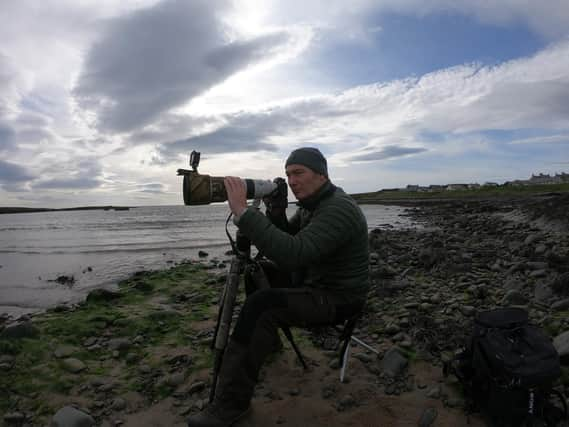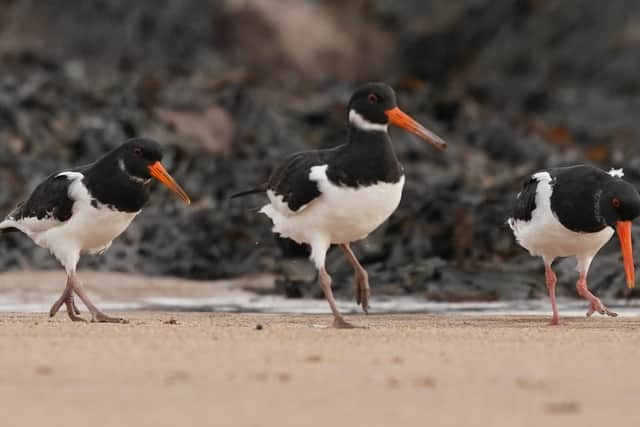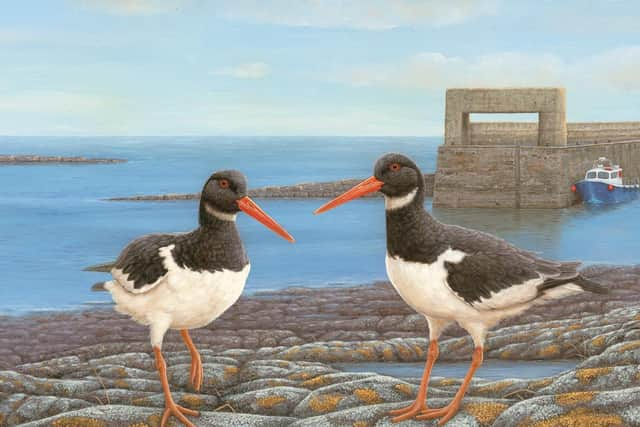Wildlife artist Robert Fuller captures Oystercatchers on film for a very special painting


Last year during a trip to watch whales and bears in Canada, I received an email to ask if I would consider painting oystercatchers at Craster Harbour in Northumberland.
My client, the children’s author, David Brazier, was very specific about including the harbour in my composition. Curious, as soon as I returned from my trip I rang to find out why the oystercatchers needed to be located at Craster.
Advertisement
Hide AdAdvertisement
Hide AdI discovered that this painting was to be an engagement gift and that the harbour is a favourite holiday destination for David and his partner.
They have special memories of watching oystercatchers there and he thought it romantic that he often saw these birds operating together in a pair.
Initially, David, who planned to propose at the harbour on November 11, was going to give his partner my painting at the same time.
But, unfortunately, this wasn’t going to give me enough time to complete the project so we agreed that it would be a Christmas gift commemorating the occasion.
Advertisement
Hide AdAdvertisement
Hide AdDavid wanted an oil painting and oils take a lot longer than acrylics because of the length of time each coat needs to dry.


I decided to take a day off to drive up to Craster Harbour to gather reference material for my painting. I reasoned that being out in the fresh air would give me a welcome break from my easel.
I have only painted oystercatchers once before so I was going to need to get to know them better if I was going to get my painting right.
The trouble was I had no clear idea whether I was going to actually see any when I got there.
Advertisement
Hide AdAdvertisement
Hide AdI decided to set off very early one morning in order to be there at low tide when I hoped that if they were going to be any oystercatchers at all they might be feeding.


It was a chilly overcast day and as I got out of my car I was met with a brisk wind. I grabbed my binoculars and scanned the exposed beach, but before I even had time to focus my lenses I heard their unmistakable, piping call.
On the beach, I picked out six; probing the sand with long, orange beaks. My priority was to photograph the birds and then think about the background later.
And so I grabbed my cameras and tripod and slowly approached the group as they rushed back and forth on the sand, their movements in sync with each wave.
Advertisement
Hide AdAdvertisement
Hide AdAn oystercatcher’s day revolves with the tides. It feeds on the cockles, mussels, limpets, crabs, shrimps and worms that are exposed on the sand and rocks when the tide is out. Then it rests when the tide comes in.
Once I was close enough to be able to take good reference photographs, I sat quietly to watch. And this small group of birds turned out to be so engaging.
They have striking black and white plumage and long orange beaks which they use to skewer open mussels – and oysters.
When running, their legs move so fast they look like clockwork toys, comically jogging along the beach, and for much of the time they are very noisy and argumentative.
Advertisement
Hide AdAdvertisement
Hide AdI watched as pairs defended small patches of beach from one another. They would arch their backs, lower their bright beaks and let out an angry peep.
I could see their appeal – and also the draw of Craster, which is an undoubtedly a beautiful bit of coastline. No wonder David wanted to capture the memory of watching oystercatchers here.
I too was mesmerised and it wasn’t until the tide turned and the waves were lapping at my feet that I realised I had snapped more than 1,500 photographs.
Still, I was disappointed when the birds took off and flew to a long low island a hundred metres out to sea.
Advertisement
Hide AdAdvertisement
Hide AdI went back to my car for some lunch and continued to watch them through my binoculars. Mostly they stood facing the wind, each one propped up on one leg with its beak tucked under its wing. Occasionally one would lift its head briefly to preen, and then resume its one-legged stance to rest.
Then I noticed a few oystercatchers fly off the island and head down the coast and out of sight. I couldn’t resist following this group along the rocky coastline.
When I eventually caught up with them they had joined a flock of 50 roosting on the rocks. Moving among them were turnstones, busily rolling seaweed and stones to look for food underneath, glistening flocks of golden plovers wheeling over the sea, and even eider ducks.
It was as though the landscape had come alive and I watched entranced for a number of hours before remembering that David’s proposal was going to be at sunset and that I still needed to gather reference material at the harbour.
Advertisement
Hide AdAdvertisement
Hide AdIt had been overcast all day, but now, as if on cue, the clouds cleared and I took my final photographs as the last rays of sun glinted over the deep blue water.
I hastened back to the spot where I knew David intended to propose. Not only did I want to soak up a bit of the atmosphere as the sun lowered in the sky, but I also needed to know exactly where it would be set if my painting was going to be accurate.
Brimming with new ideas for my composition and with a camera full of inspirational photographs, I headed home, satisfied and excited at the prospect of bringing all my ideas together into a new painting.
Back in my studio, I chose to position a pair of oystercatchers on lichen-covered rocks, their orange legs reverberating against the deep blue of the harbour behind them.
Advertisement
Hide AdAdvertisement
Hide AdIn the background, I inscribed the date, and time, 11.11.11, of David’s proposal on to a boat tied up in the harbour.
David was delighted with this, since he had deliberately chosen the day due to a deep spiritual significance of the number 11.
And in fact he was so pleased he also asked that the boat be named after his fiancé’s late mother, Aileen.
It is very unusual for me to have included so much symbolism in my artwork, but in fact I found it a heartening to be part of such a meaningful story.